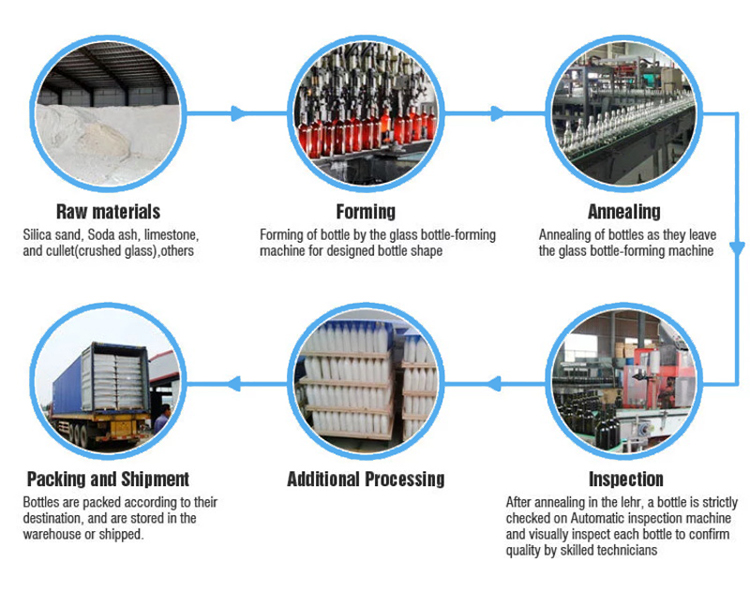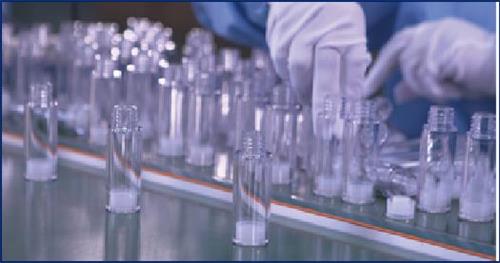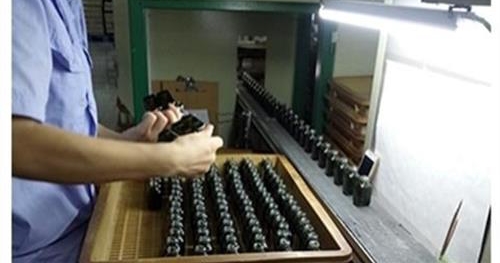
Cullet: Glass bottles and jars are made of three nature ingredients: silica sand, soda cash and limestone. The materials are mixed with recycled glass, called “cullet”. Cullet is the main ingredient in the glass bottles and containers. Globally, our glass packaging contains an average of 38% recycled glass. The raw materials (quartz sand, soda ash, limestone, feldspar, etc.) are crushed, the wet raw materials to be dried, and the iron-containing raw materials are treated with iron removal to ensure the quality of glass.
Furnace: The batch mixture heads to the furnace, the furnace is heated by gas and electricity to about 1550 degrees celsius to create molten glass. The furnace runs 24 hours a day, seven days a week, and can process several hundred tonnes of glass each day.
Refiner: When the molten glass mixture comes out of the furnace, it flows into a refiner, which is essentially a holding basin covered by a big crown to contain the heat. Here the molten glass cools to about 1250 degrees celsius and air bubbles trapped inside make their escape.
Forehearth: The molten glass then goes to the forehearth, which brings the glass temperature to a uniform level before entering the feeder. At the end feeder, shears cut the molten glass into “gobs”, and each gob will become a glass bottle or jar.
Forming Machine: The end product starts to take shape inside the forming machine as each gob is dropped into a series of molds. Compressed air is used to shape and expand the gob into a glass container. The glass continues cooling at the point in the manufacturing process, dropping to roughly 700 degrees celsius.
Annealing: After the forming machine, each glass bottle or jar goes through an annealing step. Annealing is needed because the outside of the container cools quicker than the inside of it. The annealing process reheats the container and is then gradually cooled to release stress and strengthen the glass. Glass containers are heated to about 565 degrees celsius and then cooled slowly to 150 degrees celsius. Then the glass bottles ad jars head to the code end coater for a final outside coating.
Inspecting Glass Bottles and Jars: Each glass bottle and jar is put through a series of inspections to ensure it meets highest standards. Multiple high-resolution cameras inside machines scan as many as 800 glass bottles each minute. The cameras sit at different angles and can catch miniscule defects. Another part of the inspection processes includes machines exerting pressure on the glass containers to test wall thickness, strength and if the container seals correctly. The experts also manually and visually inspect random samples to ensure quality.


If a glass bottle or glass jar doesn’t pass inspection, it goes back into the glass manufacturing process as cullet. Containers that pass inspection are prepared for transportation to food and beverage manufacturers, who fill them and then distribute to grocery stores, restaurants, hotels and other retail locations for shoppers and customers to enjoy.
Glass is endlessly recyclable, and a recycled glass container can go from the recycle bin to store shelf in as little as 30 days. So once consumers and restaurants recycle their glass bottles and jars, the glass manufacturing loop starts again.
Glass bottle is the main packaging container for food, medicine and chemical industry. It has a lot of advantages, it is non-toxic, tasteless, its chemical stability is good, easy to seal, good air tightness, it is transparent material and can be observed from the outside of the package to the actual situation of the clothing. This kind of packaging is helpful to the storage of goods, it has a very good storage performance, Its surface is smooth, easy to disinfect and sterilize and it is the ideal packaging container.
Glass that has virtually no color is called colorless glass. Colorless is the preferred term instead of the word clear. Clear refers to a different value: the transparency of the glass and not its color. The proper use of the word clear would be in the phrase “clear green bottle.”
Aquamarine colored glass is a natural result of the both the naturally occurring iron found in most sands, or through the addition of iron to the mix. By reducing or increasing the amount of oxygen in the flame used to melt the sand, manufacturers can produce a more bluish-green color or a greener color.
Opaque white glass is commonly called milk glass and sometimes called Opal or white glass. It can be produced by the addition of tin, zinc oxide, fluorides, phosphates or calcium.
Green glass can be made through the addition of iron, chromium, and copper. Chromium oxide will produce yellowish green to emerald green. Combinations of cobalt, (blue) mixed with chromium (green) will produce a blue green glass.
Amber glass is produced from the natural impurities in sand, such as iron and manganese. Additives that make Amber include nickel, sulfur, and carbon.
Blue glass is colored with ingredients like cobalt oxide and copper.
Purple, amethyst and red are glass colors that are usually from the use of nickel or manganese oxides.
Black glass is usually made from high iron concentrations, but can include other substances such as carbon, copper with iron and magnesia.
Whether the batch is destined to be clear or colored glass, the combined ingredients are known as the batch mixture and is transported to a furnace and heated to a temperature of about 1565°C or 2850°F. Once melted and combined, the molten glass passes through a refiner, where trapped air bubbles are allowed to escape and then it is cooled to a uniform yet still formable temperature. A feeder then pushes the liquid glass at a constant rate through precisely-sized openings in a heat-resistant die. Shear blades cut the emerging molten glass at the precise moment to create elongated cylinders called gobs. These gobs are individual pieces, ready for forming. They enter a forming machine where, using compressed air to expand them to fill a die of the desired final shape, are made into containers.
Post time: Sep-07-2021
